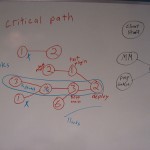
As negotiators we are always looking for a better way to conduct our next negotiation. What we’re looking for is are things like negotiation styles or negotiating techniques that we can use to gain the upper hand during the negotiation. It turns out that one of most powerful tools that we can use is something that we can use even before the negotiation starts. This tool is called the “critical path” and it can lead you to the deal that you want to reach.
What Is A “Critical Path” In A Negotiation?
The billionaire Donald Trump is known for being part of some very large real estate deals. What a lot of people don’t know is that most of these deals have been negotiated by Trump’s lead negotiator George Ross. George has years of experience when it comes to negotiating and he has developed the tools that he needs in order to get the deal that he wants. One of these tools is called the critical path method.
In a negotiation, a critical path is the sequence of events that you believe will lead you from the start of the negotiation to an ending that results in the deal that you are seeking. The starting date for your negotiation’s critical path is the date that the negotiations start. The critical path will extend to the date that you believe that negotiations will either wrap up or will need to be called off. As you put your negotiation’s critical path together, you’ll have to include estimates of how long you think that each step in the process will take.
The process of creating a critical path is important to your negotiation because it will force you to organize your thinking about how you want to go about achieving the goal that you desire. Creating a critical path is not an easy thing to do – it will take some serious thinking on your part.
How To Use The Outside Date With A Critical Path
An important part of any critical path is the date that you are forecasting that the negotiations will end on. In critical path terms, this date is called the “outside date”.
Every negotiation is a dynamic process. As you proceed in a negotiation eventually a real deadline will eventually show up. Once this happens, that date will now become your real outside date.
During the negotiation, you’ll use the outside date to determine how soon before the outside date you are going to have to complete the negotiations. Due to the variability involved in every negotiation, there is a good chance that you are going to have to consider several different scenarios and this means that you are going to have to create multiple critical paths. Becoming good at creating accurate critical paths is a fundamental negotiating skill that we all have to develop.
What All Of This Means For You
Donald Trumps’s lead negotiator, George Ross, knows a thing or two about negotiating. One of the techniques that he uses in order to be able to walk away from a negotiation with the deal that he wants is called the critical path method.
A critical path is just what it sounds like: the sequence of events and the times that they are going to take in order to for you to reach the deal that you want. Part of a critical path is the outside date which is the real deadline that you are facing. Once you know your outside date, you then know when the real negotiating needs to begin.
The critical path technique allows you to plan out your next principled negotiation. Using this tool you can take control of the negotiation and have the confidence that you’ll be able to reach the deal that you want on time. Prior to your next negotiation, create your critical path and discover how powerful this tool is.
– Dr. Jim Anderson
Blue Elephant Consulting –
Your Source For Real World Negotiating Skills™
Question For You: If things change during a negotiation, do you think that you should take the time to modify your critical path?
![]() Click here to get automatic updates when The Accidental Negotiator Blog is updated.
Click here to get automatic updates when The Accidental Negotiator Blog is updated.
P.S.: Free subscriptions to The Accidental Negotiator Newsletter are now available. Learn what you need to know to do the job. Subscribe now: Click Here!
What We’ll Be Talking About Next Time
We all hate delays, right? No matter if it is when we are in traffic, waiting in a line at a store, or waiting for the next web page to load, any sort of delay is a bad thing. Or is it? It turns out that in a negotiation, sometimes a delay can be a very good thing. We just have to learn how best to deal with them.
